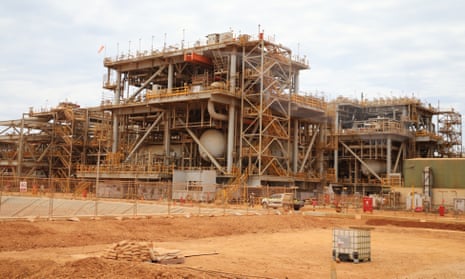Greenhouse gas emissions from Chevron’s Gorgon LNG facility have increased because the company’s carbon capture system is not working properly, meaning more carbon dioxide is being vented into the atmosphere.
Environment groups have blasted the Western Australian government for not imposing penalties on the energy company after documents revealed sand was clogging the injection system designed to bury up to 4m tonnes of carbon dioxide a year under Barrow Island.
The Conservation Council of WA said Chevron should be forced to shut the plant down until it can demonstrate its carbon capture and storage (CCS) was working.
The council’s director, Piers Verstegen, said the project had been “a disaster from the beginning” and should concern the Morrison government which has championed gas developments and the deployment of CCS technology.
Documents obtained by the independent energy news outlet, Boiling Cold, reveal the WA Department of Mines, Industry Regulation and Safety allowed Chevron to continue injecting reservoir CO2 underground while its pressure management system was not working.
The department has given the company until June this year to restore the system and has capped the amount of CO2 that can be injected, meaning more venting of emissions into the atmosphere.
Neither Chevron nor the WA government would disclose the cap or the amount by which emissions have increased.
The Gorgon CCS system, which received $60m in funding from the federal government, has been trouble-plagued. Emissions storage did not start until 2019 – three years after production at the plant began.
Reservoir CO2 emitted during the gas extraction process is the main source of local emissions caused by the project. The WA government requires Chevron to bury an average of 80% of those emissions over a five-year period beginning in 2016.
It has said any penalties for not meeting that condition would only be imposed at the end of this period in July 2021.
Conservationists have said given the previous delays in getting the CCS system operational, and its ongoing problems, Chevron can’t possibly meet this condition.
Last year, the Conservation Council of WA used the state’s Appeals Convener, which reports to the environment minister, Stephen Dawson, to challenge the operating licence issued to Chevron by the state government.
That appeal raised concerns on three main grounds: a lack of public disclosure about the CCS facility’s operations and emissions from the Gorgon project; a lack of limits on the amount of pollutants the project could emit; and the 20-year length of the operating licence before it would come up for review.
The appeal was rejected on the first two grounds but Dawson revised the length of the operating licence to 10 years.
Verstegen said poor regulatory oversight and a lack of enforcement by the WA government had allowed “the Morrison government to continue promoting this false climate solution while at the same time pushing expansion of gas production across Australia”.
“It is of immense significance, not just for the millions of tonnes of CO2 released every year at Gorgon, but for the credibility of the Morrison government’s technology roadmap and climate policy in general that we have proper transparency on what is going on here, and that this CCS project is properly regulated,” he said.
In 2018, the Australia Institute estimated that the delayed commencement of carbon capture and storage at Gorgon had been responsible for half of the increase in Australia’s annual emissions.
Mark Ogge, a principal adviser at the Australia Institute, said the Morrison government had given Chevron $60m for CCS “with no penalties attached for failure”, while the WA government had shifted the goalposts to allow the company to vent carbon dioxide “without any consequence”.
“Australians should be appalled but not surprised that carbon capture is failing again, despite taxpayers funding it,” he said.
“The government should be closing down Gorgon until the company can sequester the emissions as it is required to for the project to operate.”
He added that the company was being asked to sequester a “tiny fraction” of the overall climate impact the project would have once the gas is exported and burnt.
A spokesperson for Chevron said the CCS system was working safely.
“Like any pioneering endeavour, the carbon capture sequestration system has presented some challenges and we continue to monitor and optimise system performance, with a focus on long-term, safe, efficient and reliable operation over its 40-plus year life,” they said.
The company confirmed some “short-term” changes had been made to the system’s operating limits and daily injection rates had been amended to allow for additional venting – but she did not say by how much.
“We are committed to meeting our regulatory obligations over the more than 40-year life of the Gorgon natural gas facility.”
A spokesperson for Dawson said it was not accurate to say Chevron had failed to meet its conditions of approval with regard to carbon sequestration.
“Chevron is required to ensure that, calculated on a five-year rolling average, at least 80% of reservoir carbon dioxide removed during the licensed gas processing operations on Barrow Island that would be otherwise vented to the atmosphere is injected,” they said.
The state minister’s office said if the department of water and environmental regulation found after July this year that Chevron had failed to comply “the department will consider its regulatory options”.
A spokesperson for the federal energy and emissions reduction minister, Angus Taylor said: “The Intergovernmental Panel on Climate Change and the International Energy Agency have concluded the Paris goals cannot be achieved without carbon sequestration deployed at scale.”
